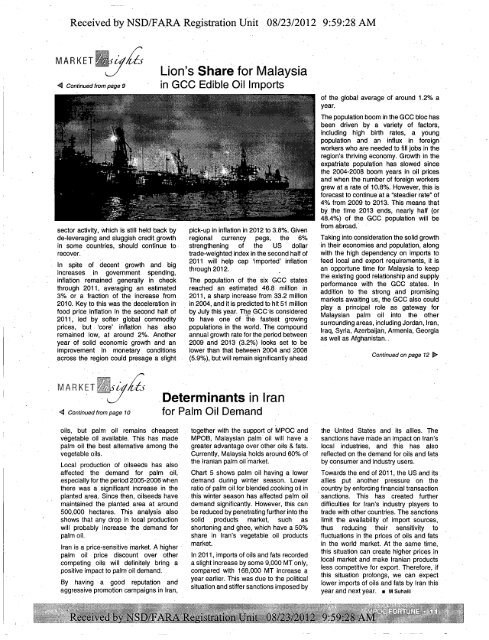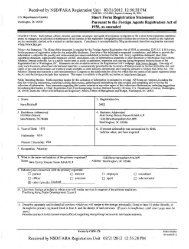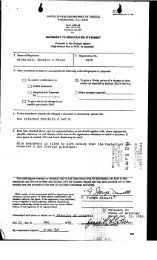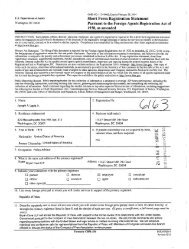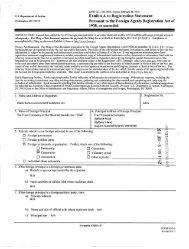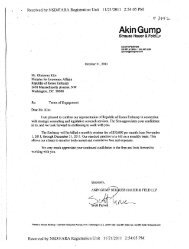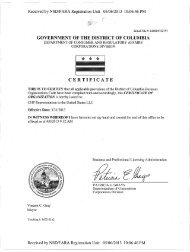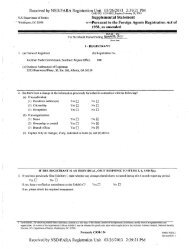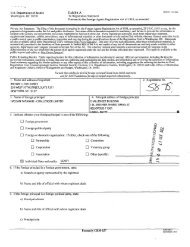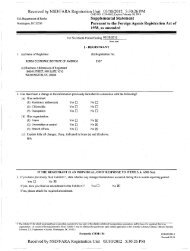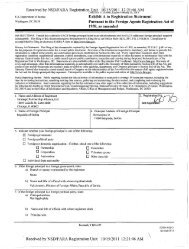Supplemental Statement - FARA
Supplemental Statement - FARA
Supplemental Statement - FARA
Create successful ePaper yourself
Turn your PDF publications into a flip-book with our unique Google optimized e-Paper software.
Received by NSD/<strong>FARA</strong> Registration Unit 08/23/2012 9:59:28 AM<br />
lARKETJB^y^<br />
U Lion's Share for Malaysia<br />
4 Continued from page 9<br />
**<br />
(Mr*<br />
sector activity, which is still held back by<br />
de-leveraging and sluggish credit growth<br />
in some countries, should continue to<br />
recover.<br />
In spite of decent growth and big<br />
increases in government spending,<br />
inflation remained generally in check<br />
through 2011, averaging an estimated<br />
3% or a fraction of the increase from<br />
2010. Key to this was the deceleration in<br />
food price inflation in the second half of<br />
2011, led by softer global commodity<br />
prices, but 'core' inflation has also<br />
remained low, at around 2%. Another<br />
year of solid economic growth and an<br />
improvement in monetary conditions<br />
across the region could presage a slight<br />
PJ-,<br />
IARKET»*V/£&<br />
Continued from page 10<br />
oils, but palm oil remains cheapest<br />
vegetable oil available. This has made<br />
palm oil the best alternative among the<br />
vegetable oils.<br />
Local production of oilseeds has also<br />
affected the demand for palm oil,<br />
especially for the period 2005-2006 when<br />
there was a significant increase in the<br />
planted area. Since then, oilseeds have<br />
maintained the planted area at around<br />
500,000 hectares. This analysis also<br />
shows that any drop in local production<br />
will probably increase the demand for<br />
palm oil.<br />
Iran is a price-sensitive market. A higher<br />
palm oil price discount over other<br />
competing oils will definitely bring a<br />
positive impact to palm oil demand.<br />
By having a good reputation and<br />
aggressive promotion campaigns in Iran,<br />
in GCC Edible Oil Imports<br />
^<br />
rrf*-<br />
SSF<br />
- iSti £gv<br />
'J<br />
-tfW?<br />
pick-up in inflation in 2012 to 3.8%. Given<br />
regional currency pegs, the 6%<br />
strengthening of the US dollar<br />
trade-weighted index in the second half of<br />
2011 will help cap 'imported' inflation<br />
through 2012.<br />
The population of the six GCC states<br />
reached an estimated 46.8 million in<br />
2011, a sharp increase from 33.2 million<br />
in 2004, and it is predicted to hit 51 million<br />
by July this year. The GCCis considered<br />
to have one of the fastest growing<br />
populations in the world. The compound<br />
annual growth rate for the period between<br />
2009 and 2013 (3.2%) looks set to be<br />
lower than that between 2004 and 2008<br />
(5.9%), but will remain significantly ahead<br />
Determinants in Iran<br />
for Palm Oil Demand<br />
together with the support of MPOC and<br />
MPOB, Malaysian palm oil will have a<br />
greater advantage over other oils & fats.<br />
Currently, Malaysia holds around 60% of<br />
the Iranian palm oil market.<br />
Chart 5 shows palm oil having a lower<br />
demand during winter season. Lower<br />
ratio of palm oil for blended .cooking oil in<br />
this winter season has affected palm oil<br />
demand significantly. However, this can<br />
be reduced by penetrating further into the<br />
solid products market, such as<br />
shortening and ghee, which have a 50%<br />
share in Iran's vegetable oil products<br />
market.<br />
In 2011, imports of oils and fats recorded<br />
a slight increase by some 9,000 MT only,<br />
compared with 168,000 MT increase a<br />
year earlier. This was due to the political<br />
situation and stiffer sanctions imposed by<br />
Received by NSD/<strong>FARA</strong> Registration Unit 08/23/2012 9:59:28 AM<br />
n<br />
^<br />
of the global average of around 1.2% a<br />
year.<br />
The population boom in the GCC bloc has<br />
been driven by a variety of factors,<br />
including high birth rates, a young<br />
population and an influx in foreign<br />
workers who are needed to fill jobs in the<br />
region's thriving economy. Growth in the<br />
expatriate population has slowed since<br />
the 2004-2008 boom years in oil prices<br />
and when the number of foreign workers<br />
grew at a rate of 10.8%. However, this is<br />
forecast to continue at a "steadier rate" of<br />
4% from 2009 to 2013. This means that<br />
by the time 2013 ends, nearly half (or<br />
48.4%) of the GCC population will be<br />
from abroad.<br />
Taking into consideration the solid growth<br />
in their economies and population, along<br />
with the high dependency on imports to<br />
feed local and export requirements, it is<br />
an opportune time for Malaysia to keep<br />
the existing good relationship and supply<br />
performance with the GCC states. In<br />
addition to the strong and promising<br />
markets awaiting us, the GCC also could<br />
play a principal role as gateway for<br />
Malaysian palm oil into the other<br />
surrounding areas, including Jordan, Iran,<br />
Iraq, Syria, Azerbaijan, Armenia, Georgia<br />
as well as Afghanistan..<br />
Continued on page 12 •<br />
the United States and its allies. The<br />
sanctions have made an impact on Iran's<br />
local industries, and this has also<br />
reflected on the demand for oils and fats<br />
by consumer and industry users.<br />
Towards the end of 2011, the US and its<br />
allies put another pressure on the<br />
country by enforcing financial transaction<br />
sanctions. This has created further<br />
difficulties for Iran's industry players to<br />
trade with other countries. The sanctions<br />
limit the availability of import sources,<br />
thus reducing their sensitivity to<br />
fluctuations in the prices of oils and fats<br />
in the world market. At the same time,<br />
this situation can create higher prices in<br />
local market and make Iranian products<br />
less competitive for export. Therefore, if<br />
this situation prolongs, we can expect<br />
lower imports of oils and fats by Iran this<br />
year and next year. • M suhaiii


